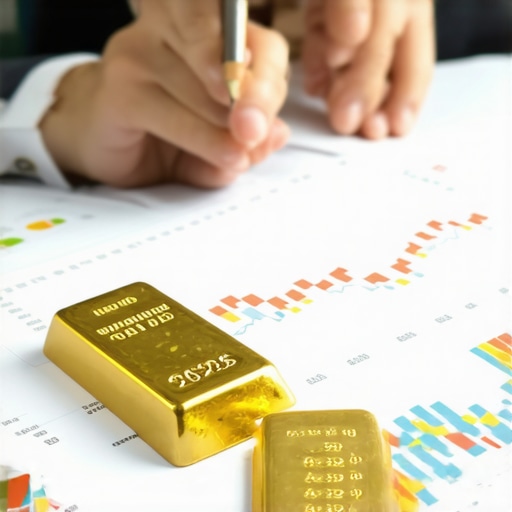Unearthing the Hidden Forces Behind Gold Demand in 2025
As we delve into 2025, the global gold market reveals an intricate tapestry woven from economic uncertainty, shifting geopolitical alliances, and evolving investor behavior. Far beyond being a mere commodity, gold remains an emblematic safe haven and a key portfolio diversifier in turbulent times. Understanding the nuanced trends shaping its demand is crucial for investors, analysts, and policymakers alike. This exploration unpacks the complex dynamics driving gold’s allure and price movements in the current economic landscape.
The Geopolitical and Economic Currents Steering Gold Consumption
Global gold demand is profoundly influenced by macroeconomic factors such as inflation rates, currency fluctuations, and central bank policies. In 2025, persistent inflationary pressures and cautious monetary tightening in major economies have invigorated gold’s appeal as an inflation hedge. Additionally, geopolitical tensions—ranging from trade disputes to regional conflicts—have stimulated increased buying by sovereign entities and private investors seeking stability.
Notably, central banks worldwide continue to expand their gold reserves, reflecting a strategic pivot towards tangible assets amid uncertain financial markets. According to the World Gold Council’s latest report, central bank gold purchases reached record highs in the first quarter of 2025, underscoring this trend (World Gold Council, 2025).
How Are Emerging Markets Shaping Gold Demand Patterns?
Emerging economies, particularly in Asia, remain pivotal in the gold demand equation. Countries like India and China not only dominate jewelry consumption but are also witnessing surging investment demand through gold ETFs and digital platforms. The rise of a burgeoning middle class with increasing disposable income fuels sustained appetite for gold jewelry and investment products, despite fluctuating local economic conditions.
Moreover, innovative fintech solutions facilitating gold purchases have democratized access, enabling smaller investors to participate actively. This democratization alters traditional demand curves and introduces new volatility factors tied to retail investor sentiment.
Supply Constraints and Their Ripple Effects on Gold Prices
While demand dynamics are crucial, supply-side considerations cannot be overlooked. Mining outputs have faced challenges due to stricter environmental regulations, labor shortages, and geopolitical disruptions in key gold-producing regions. These constraints have tightened physical supply, amplifying price sensitivity to demand shocks.
Secondary sources such as recycling and scrap gold have partially mitigated supply deficits but remain insufficient to fully balance the market. This supply-demand imbalance underpins the bullish price outlook for 2025, as elaborated in recent market analyses (Understanding Global Gold Demand Trends and Market Impact 2025).
Investor Behavior and the Evolution of Gold Investment Vehicles
The gold investment landscape is evolving rapidly, with ETFs, mutual funds, and digital gold platforms gaining prominence. This diversification of investment vehicles has broadened market participation and enhanced liquidity. Investors increasingly prefer gold ETFs for their convenience and cost efficiency, while traditional physical gold retains its appeal for wealth preservation.
Innovations in gold trading apps and algorithmic trading strategies are also shaping market dynamics, creating new opportunities and risks. Investors must stay informed about these tools to optimize portfolio performance amid fluctuating gold prices.
What Are the Key Strategies to Navigate Gold Price Volatility in 2025?
Managing gold price volatility requires a multifaceted approach: diversifying across physical and paper gold investments, monitoring macroeconomic indicators, and leveraging expert market analyses. Strategic allocation to gold within diversified portfolios can hedge against inflation, currency risks, and equity market downturns. Staying abreast of gold price forecasts and economic drivers equips investors to make timely decisions aligned with market trends.
Engage with this evolving gold market landscape by sharing your thoughts or experiences below—your insights enrich the community’s understanding and preparedness.
Reflections on Balancing Physical Gold and Digital Investments
When I first started investing in gold, I was drawn to the tangible security of physical gold bars and coins. There’s something undeniably reassuring about holding a physical asset in your hands—it’s a legacy of wealth passed down through generations. However, as I witnessed the market evolve, I realized the importance of embracing digital gold investment options, such as ETFs and mutual funds, which offer liquidity and ease of access.
Balancing these two forms of gold investment has been a personal journey. Physical gold is excellent for wealth preservation and hedging against systemic risks, but it comes with storage and insurance considerations. On the other hand, digital gold vehicles provide flexibility and often lower transaction costs, yet they expose investors to counterparty risks. This dual approach has helped me spread risk and capture opportunities across the spectrum.
The Role of Technology in Democratizing Gold Investment
One of the most exciting developments I’ve encountered recently is how fintech platforms have opened doors for smaller investors. Apps now allow fractional gold ownership, making it accessible to people who previously might have felt excluded due to high entry costs. I recall a conversation with a young professional who started investing in gold through a digital platform with just a few dollars a month. This shift is reshaping traditional demand and adding new dimensions to market behavior.
According to a World Gold Council report, retail investors contributed significantly to gold demand growth in recent years, highlighting the profound impact of technology. However, this also means investors must be cautious and well-informed, as market sentiment can fluctuate more rapidly with increased retail participation.
Have You Explored the Pros and Cons of Physical Gold Versus Gold ETFs?
This question often comes up among my friends and readers. Physical gold offers the comfort of a tangible asset, but it requires careful storage, insurance, and sometimes a premium over spot prices. Conversely, gold ETFs provide easy trading and diversification but depend on financial intermediaries and market liquidity.
If you’re considering starting or expanding your gold portfolio, I encourage you to weigh these factors thoughtfully. For a detailed look into gold ETFs and mutual funds, their benefits, and how they fit into a diversified portfolio, check out this comparison of gold ETFs and mutual funds.
Lessons Learned from Market Volatility and Investor Sentiment
Over the years, I’ve noticed that gold price volatility often reflects broader market anxieties and investor sentiments. For instance, during geopolitical tensions, a spike in gold buying often signals caution among investors. Conversely, periods of economic optimism can temper gold demand as risk appetite increases.
To navigate this, I’ve adopted a habit of monitoring key economic indicators and expert analyses regularly. Incorporating insights from reliable sources, like the 2025 gold price forecasts, helps me make informed decisions rather than reacting impulsively to market noise.
This approach has helped me remain patient and disciplined, especially during turbulent phases. It’s a reminder that gold, while a safe haven, is still part of a dynamic market influenced by numerous factors.
I’d love to hear your experiences and strategies in navigating gold investments. Have you leaned more towards physical gold or digital platforms? How do you manage volatility in your portfolio? Share your thoughts and stories in the comments below—your perspective could spark valuable discussions and insights for everyone in this community.
Innovative Portfolio Architectures: Leveraging Gold for Advanced Risk Management
In the evolving financial ecosystem of 2025, investors are no longer confined to traditional asset allocation models. The integration of gold into sophisticated portfolio architectures demands a granular understanding of its multifaceted role—not just as a hedge against inflation or currency devaluation, but as a dynamic instrument responsive to systemic shocks and market sentiment shifts.
Contemporary portfolio theory now incorporates gold’s non-correlation benefits with equities and bonds, but also factors in liquidity considerations, tax efficiencies, and geopolitical risk matrices. For instance, incorporating both physical gold and gold-backed derivatives can optimize liquidity while maintaining exposure to gold’s safe-haven properties. This hybrid approach requires active rebalancing strategies informed by real-time macroeconomic indicators and geopolitical developments.
Decoding Gold’s Intraday Volatility: Implications for High-Frequency Traders and Institutional Investors
While long-term gold investors focus on macro trends, intraday volatility presents unique challenges and opportunities for high-frequency traders and institutional players. Gold prices, influenced by rapid shifts in currency markets, interest rate expectations, and geopolitical news flows, exhibit nuanced price action patterns that sophisticated algorithms exploit.
Understanding these patterns requires advanced quantitative models that integrate machine learning techniques to predict micro-movements. Moreover, the increasing role of algorithmic trading raises questions about market depth and potential flash crashes—a phenomenon that demands robust risk controls and real-time monitoring systems.
How Do Central Bank Digital Currencies (CBDCs) Influence Gold Demand and Market Dynamics?
The advent of CBDCs introduces an intriguing layer of complexity in gold markets. Central bank digital currencies, designed to modernize monetary systems and enhance transaction efficiency, could alter traditional gold demand drivers in several ways.
Firstly, CBDCs may reduce the reliance on physical cash, potentially increasing the appeal of gold as a non-digital store of value amid digital currency uncertainties. Conversely, enhanced monetary policy transmission through CBDCs might stabilize inflation expectations, thereby moderating the inflation-hedge demand for gold.
Furthermore, cross-border CBDC interoperability could impact currency volatility, indirectly influencing gold’s role as a safe haven. Emerging research from the International Monetary Fund highlights these dynamics, suggesting a nuanced interplay between digital currency adoption and gold market behavior (IMF Working Paper, 2023).
Environmental, Social, and Governance (ESG) Criteria: Transforming Gold Mining and Investment Perspectives
The gold mining sector faces mounting pressure to align with ESG standards, which significantly impacts supply dynamics and investor sentiment. Mining companies adopting sustainable practices—such as reduced carbon footprints, responsible sourcing, and community engagement—are increasingly favored by ESG-conscious investors.
This shift not only affects the operational costs and capital expenditure profiles of mining firms but also influences the premium investors are willing to pay for “green” gold. Innovations in traceability, powered by blockchain technology, enable verifiable ESG compliance, thus enhancing transparency and market confidence.
Consequently, ESG considerations are becoming integral in portfolio selection, with dedicated gold investment products emerging that prioritize ethical sourcing. This trend is reshaping the supply side and could contribute to tighter supply conditions if lagging producers face divestment or regulatory hurdles.
Harnessing Behavioral Finance Insights to Decode Retail Gold Investor Psychology
Retail investor participation, amplified by fintech platforms, introduces behavioral biases that affect gold market dynamics. Cognitive phenomena such as herd behavior, overconfidence, and loss aversion manifest distinctly in gold investment patterns, impacting price volatility and market liquidity.
Understanding these psychological drivers enables portfolio managers and advisors to better anticipate retail flows and design communication strategies that mitigate irrational exuberance or panic selling. Advanced sentiment analysis tools, leveraging social media and transaction data, provide real-time insights into retail investor mood swings.
What Advanced Risk Mitigation Techniques Can Investors Employ to Navigate Gold Market Uncertainties?
Beyond diversification, advanced risk mitigation encompasses tactical hedging using options and futures, dynamic allocation adjustments based on volatility regimes, and scenario analysis incorporating geopolitical contingencies. Sophisticated investors may also utilize gold-linked structured products designed to deliver asymmetric risk-return profiles.
Staying informed through authoritative forecasts and market intelligence, such as those provided by the World Gold Council’s research hub, is crucial to implement these strategies effectively. Engaging with expert analyses and participating in specialized forums can further enhance decision-making acuity.
For those eager to elevate their gold investment approach, I invite you to explore these advanced concepts and share your experiences. How do you integrate technological innovations, ESG considerations, or behavioral insights into your gold portfolio management? Your contributions enrich this expert community’s collective wisdom.
Integrating Macroeconomic Signals into Tactical Gold Allocation
In an environment characterized by rapid policy shifts and volatile economic indicators, discerning investors adopt a proactive stance towards gold allocation. This involves continuous monitoring of inflation expectations, real interest rates, and currency dynamics to recalibrate exposure. Particularly, the nuanced interplay between Federal Reserve policies and emerging market central bank actions demands real-time analytical rigor. Leveraging macroeconomic dashboards and predictive analytics can illuminate inflection points where gold’s role as an inflation hedge or safe haven intensifies.
Blockchain-Enabled Transparency: Revolutionizing Gold Provenance and Trust
The deployment of blockchain technology in gold supply chains is transforming provenance verification, fostering unprecedented transparency and accountability. By immutably recording each transaction from mine to market, stakeholders can authenticate ethical sourcing and ESG compliance. This technological evolution not only bolsters investor confidence but also mitigates reputational risks associated with conflict minerals. Industry leaders are increasingly adopting blockchain frameworks to meet the stringent demands of ESG-conscious investors and regulatory bodies.

What Quantitative Models Best Capture Gold’s Response to Macroeconomic Shocks?
Advanced econometric models, including regime-switching frameworks and vector autoregression (VAR), are instrumental in capturing gold’s sensitivity to macroeconomic shocks. These models account for structural breaks and nonlinear dependencies, enabling sophisticated forecasting amid uncertainty. Incorporating high-frequency data enhances temporal resolution, while machine learning algorithms can uncover latent patterns in price movements triggered by geopolitical events or policy announcements. For practitioners, the World Gold Council’s research hub offers a repository of rigorous studies elucidating these methodologies.
Strategic Hedging with Derivatives: Elevating Portfolio Resilience
Institutional investors increasingly harness gold derivatives—options, futures, and structured products—to fine-tune risk profiles. Employing option strategies such as protective puts or collars can mitigate downside exposure while preserving upside participation. Dynamic delta-hedging techniques enable responsiveness to intraday volatility, optimizing capital efficiency. Moreover, integrating scenario-based stress testing informs strategic hedging decisions, aligning them with evolving geopolitical and economic landscapes.
Engage with the Frontier of Gold Market Expertise
The multifaceted nature of gold investing in 2025 calls for an intersectional approach, synthesizing macroeconomic intelligence, technological innovation, and advanced quantitative tools. I encourage you to delve deeper into these sophisticated strategies and share your experiences or questions. How are you leveraging emerging technologies or advanced analytics to enhance your gold investment acumen? Join the conversation and contribute to this evolving discourse.
Frequently Asked Questions (FAQ)
What factors are currently driving the surge in global gold demand in 2025?
Gold demand in 2025 is primarily propelled by persistent inflationary pressures, geopolitical uncertainties, and central banks’ strategic accumulation of reserves. The inflation hedge appeal of gold remains strong amid cautious monetary policies, while emerging markets with growing middle classes contribute robust jewelry and investment demand. Additionally, fintech innovations have broadened retail investor participation, further elevating demand.
How do emerging markets like India and China influence gold consumption patterns?
India and China dominate global gold consumption through substantial jewelry demand and fast-growing investment channels such as ETFs and digital platforms. Rising disposable incomes, cultural affinity for gold, and improved fintech accessibility are driving sustained appetite. These markets also introduce volatility due to retail investor sentiment and economic fluctuations.
What supply challenges are impacting gold availability and prices?
Gold supply faces constraints from stricter environmental regulations, labor shortages, and geopolitical disruptions in key mining regions. While recycling and scrap gold partially offset deficits, they are insufficient to balance demand fully. These supply limitations contribute to price sensitivity and support a bullish price outlook in 2025.
Should investors prefer physical gold or digital gold investment vehicles?
Both physical gold and digital vehicles like ETFs have distinct advantages and risks. Physical gold offers tangible security and legacy preservation but entails storage and insurance costs. Digital gold ensures liquidity, ease of access, and cost efficiency but carries counterparty risk. A balanced portfolio often incorporates both to optimize diversification and risk management.
How does technology, such as blockchain and fintech platforms, affect gold investment?
Blockchain enhances gold provenance transparency and ESG compliance, boosting investor confidence. Fintech platforms democratize gold access by enabling fractional ownership and seamless transactions, expanding retail participation. However, these innovations also introduce new behavioral dynamics and require investors to remain vigilant about market sentiment and risks.
What role do ESG considerations play in modern gold mining and investment?
ESG criteria increasingly influence gold mining operations, with a focus on sustainable practices, reduced carbon footprints, and ethical sourcing. Investors favor companies and products demonstrating verified ESG compliance, which can command premiums and reshape supply by pressuring laggards. Blockchain-enabled traceability supports this transformation by ensuring transparency.
How can investors manage gold price volatility effectively?
Effective volatility management involves diversifying across physical and paper gold, utilizing derivatives for hedging, monitoring macroeconomic indicators, and employing scenario analysis. Staying informed through expert forecasts and adopting dynamic allocation strategies aligned with evolving geopolitical and economic contexts improves resilience.
In what ways do Central Bank Digital Currencies (CBDCs) impact gold markets?
CBDCs may alter gold demand by affecting cash usage and inflation expectations. They could increase gold’s appeal as a non-digital store of value amid digital currency uncertainties or stabilize inflation, thereby moderating demand. Cross-border CBDC interoperability might change currency volatility, indirectly influencing gold’s safe-haven role.
What advanced quantitative models help forecast gold price movements?
Regime-switching models, vector autoregression (VAR), and machine learning algorithms capture gold’s response to macroeconomic shocks and geopolitical events. These models accommodate nonlinearities and structural breaks, enhancing forecast accuracy. High-frequency data integration and sentiment analysis further deepen insights into price dynamics.
How can behavioral finance insights improve understanding of retail gold investor psychology?
Behavioral biases such as herd behavior, overconfidence, and loss aversion significantly shape retail gold investment patterns. Recognizing these tendencies enables better anticipation of market flows and volatility. Sentiment analysis tools leveraging social media and transaction data offer real-time perspectives to inform portfolio management and communication strategies.
Trusted External Sources
- World Gold Council (WGC): The WGC provides comprehensive data, research, and market analysis on gold demand, supply, investment trends, and ESG initiatives, serving as a cornerstone resource for understanding global gold markets.
- International Monetary Fund (IMF): IMF working papers and reports explore the implications of Central Bank Digital Currencies and macroeconomic policies on gold markets, offering authoritative insights into monetary innovations affecting gold dynamics.
- London Bullion Market Association (LBMA): As the global authority on precious metals trading standards and market operations, LBMA supplies critical information on gold market structure, pricing, and responsible sourcing.
- Academic Journals such as the Journal of Commodity Markets: These peer-reviewed publications offer rigorous econometric analyses and quantitative modeling studies that elucidate gold price behavior and macroeconomic interactions.
- Specialized Financial Publications (e.g., Bloomberg, Reuters): These outlets provide timely market intelligence, expert commentary, and real-time data crucial for tracking gold market developments and investor sentiment.
Conclusion
In 2025, gold remains a multifaceted asset shaped by an intricate interplay of economic factors, geopolitical currents, technological advancements, and evolving investor behaviors. Its enduring role as a safe haven and inflation hedge is complemented by emerging influences such as ESG imperatives, digital transformation, and sophisticated quantitative strategies. Navigating this complex landscape demands a balanced approach that combines physical and digital gold exposures, informed by macroeconomic monitoring and advanced risk management techniques.
As the gold market continues to evolve, embracing innovations like blockchain transparency and fintech democratization will be pivotal for investors seeking optimized portfolios. By integrating behavioral insights and leveraging authoritative research, market participants can better anticipate shifts and capitalize on opportunities.
We invite you to engage further with this dynamic topic—share your experiences, explore related expert analyses, and apply these insights to enhance your gold investment strategy in today’s challenging environment.











This comprehensive analysis of the factors influencing gold demand in 2025 really highlights how multi-dimensional the market has become. I’ve personally witnessed a surge in retail interest driven by fintech innovations, especially fractional gold ownership, which makes it more accessible than ever. It’s fascinating to see how ESG considerations are shifting the supply side, with more emphasis on sustainable mining practices and blockchain traceability — I believe this will definitely influence premium pricing for ethically sourced gold.
From a personal perspective, balancing physical gold with digital ETFs has been my approach for diversification, especially considering storage costs and counterparty risks. What’s your take on how investors can effectively hedge against intraday volatility—any specific strategies or tools that have worked well for you? Also, as central banks continue to increase reserves, do you see a scenario where physical demand might stabilize or even decline in favor of digital assets? I’d love to hear other insights on how the evolving geopolitical landscape might influence these trends.